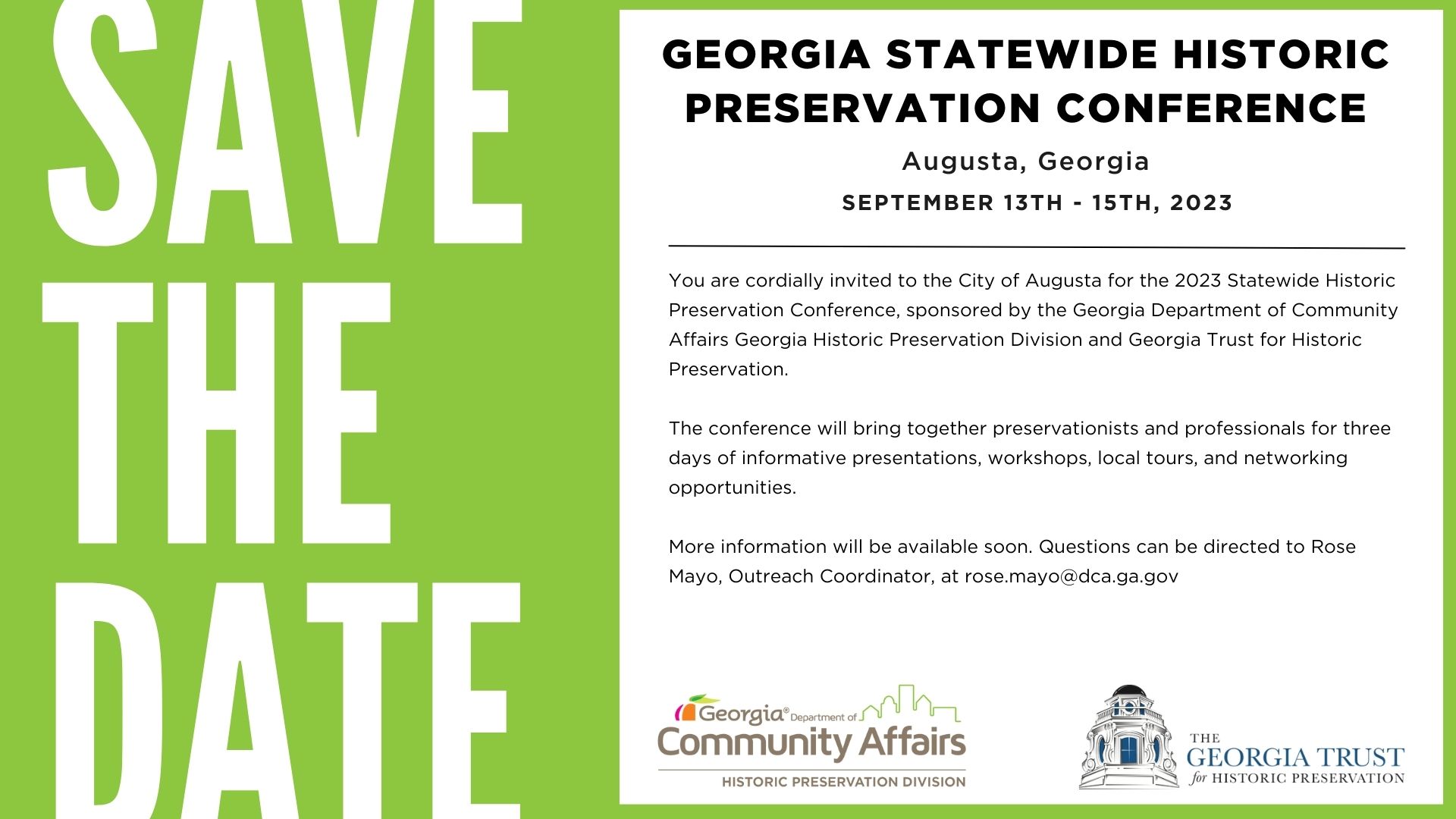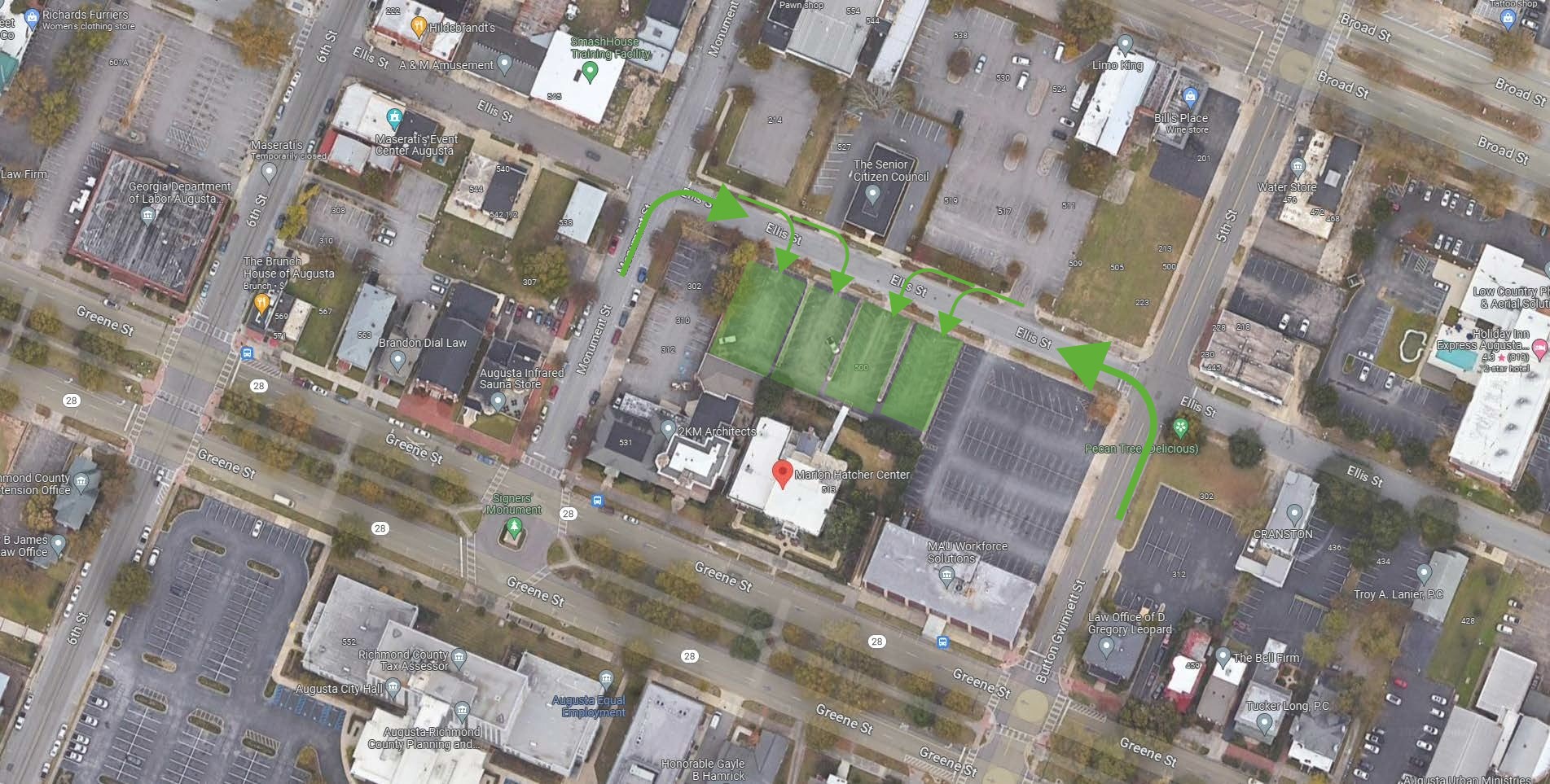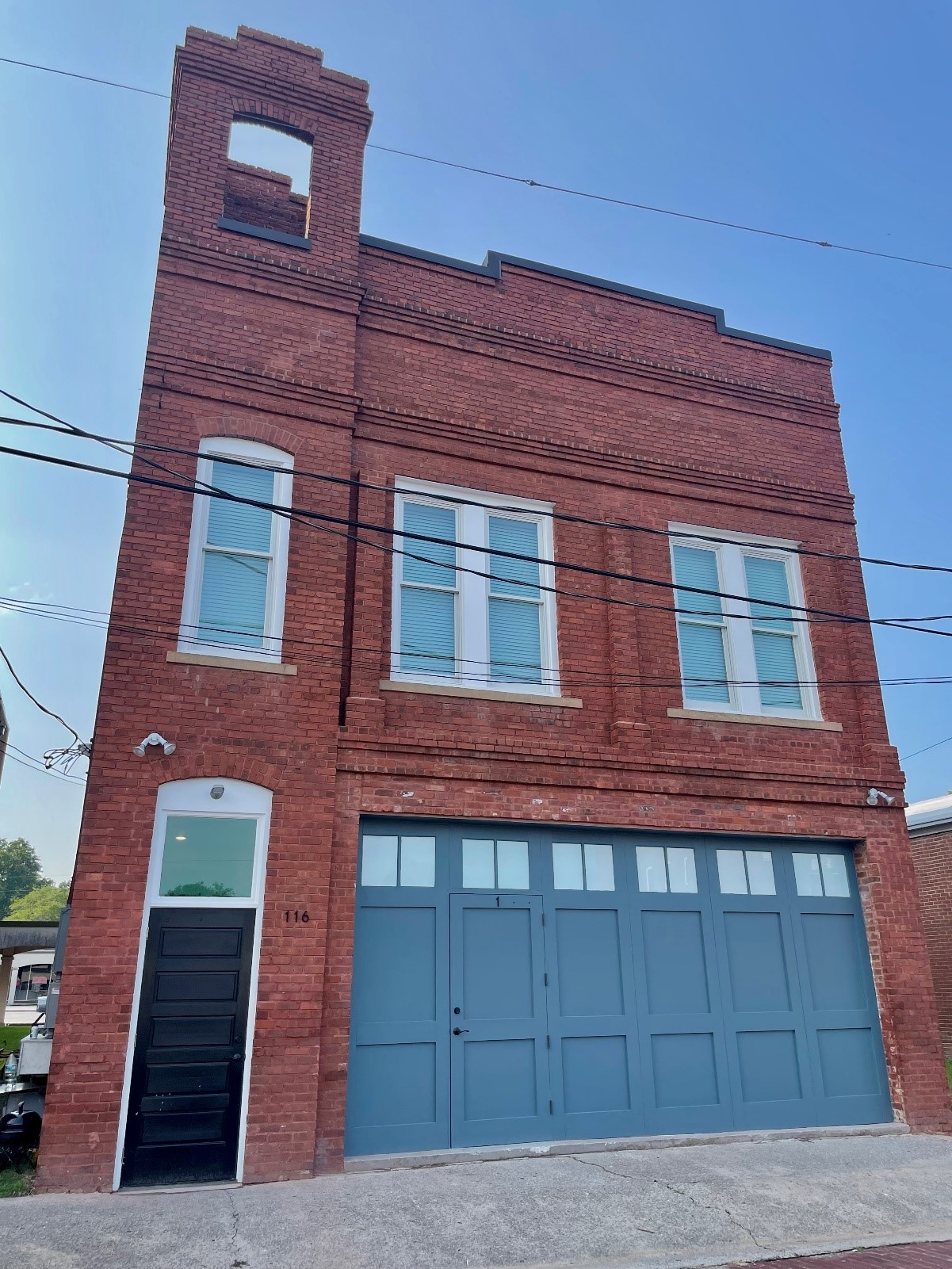Announcements

September 18-20, 2024 | Columbus, GA
We are excited to announce the 2024 Statewide Historic Preservation Conference, hosted by the Georgia Department of Community Affairs Historic Preservation Division and the Georgia Trust for Historic Preservation, will be held in Columbus, Georgia on September 18-20, 2024.
Stay up to date by signing up for HPD emails and following us on Instagram and facebook. And keep an eye on this space for more information as it is announced!
Keynote Speaker Announced
We are excited to welcome Brent Leggs as the 2024 Statewide Historic Preservation Conference Keynote Speaker.

Brent Leggs is the executive director of the African American Cultural Heritage Action Fund and senior vice president of the National Trust. Envisioned as a social movement for justice, equity, and reconciliation, the Action Fund is promoting the role of cultural preservation in telling the nation’s full history, while also empowering activists, entrepreneurs, artists, and civic leaders to advocate on behalf of African American historic places.
A Harvard University Loeb Fellow and author of Preserving African American Historic Places, which is considered the “seminal publication on preserving African American historic sites” by the Smithsonian Institution, Brent is a national leader in the U.S. preservation movement and the 2018 recipient of the Robert G. Stanton National Preservation Award. His passion for elevating the significance of black culture in American history is visible through his work, which elevates the remarkable stories and places that evoke centuries of black activism, achievement, and community.
Over the past decade, he has developed the Northeast African American Historic Places Outreach Program, and its theme, the Business of Preservation, to build a regional movement of preservation leaders saving important landmarks in African American history. As the project manager for several National Treasure campaigns across the country, he led efforts to create the Birmingham Civil Rights National Monument in Alabama, which President Barack Obama designated in January 2017. Other campaign successes include the perpetual protection of cultural monuments like Villa Lewaro, the estate of Madam C. J. Walker in Irvington, New York; Joe Frazier’s Gym in Philadelphia, Pennsylvania; Hinchliffe Stadium in Paterson, New Jersey; A. G. Gaston Motel in Birmingham; Nina Simone’s birthplace in Tryon, North Carolina; John and Alice Coltrane’s home in Huntington, New York; and more.
Brent has taught at Harvard University, Boston Architectural College and the University of Maryland. He is a Senior Advisor and Adjunct Associate Professor at the University of Pennsylvania’s Center for the Preservation of Civil Rights Sites (CPCRS) and is an Adjunct Professor at Columbia University’s graduate program in Historic Preservation.
Preliminary Schedule and Session List
We have a lot of great sessions and panels planned for you! Please note this is not the final agenda – keep an eye out for a more detailed conference packet coming soon.
View the preliminary schedule and session list here
New this year: Conference Sponsorships
We are opening sponsorship opportunities! Various levels of sponsorship are available to organizations, companies, and individuals looking to support the 2024 Statewide Historic Preservation Conference.
To inquire about sponsorships, contact Brynn Chanudet, Senior Director of Development with the Georgia Trust for Historic Preservation, bchanudet@georgiatrust.org
Registration
Registration is now open on the Georgia Trust for Historic Preservation's Website! During registration, you can also sign up for tours and new workshops, and rsvp for receptions.
Early-bird full registration is $175 until July 31. Online registration will increase by $25 on August 1 and will close August 31. Following that, walk-up on-site registration will be $225 for all.
Tours and Workshops
Tours this year include the Gertrude “Ma” Rainy House and Blue Museum; Carson McCullers Center for Writers and Artists; St. James AME Church; a bike tour of Uptown Columbus; and a cemetery workshop at Pierce Chapel African Cemetery. We are also excited to announce workshops led by HPD staff focusing on the National Register program, Environmental Review process, and Tax Incentives. Sign up for these options when you register. Tour capacity is limited. More information on the tours and workshops can be found here.
Hotel Block Information
Room blocks have been arranged at the following hotels. Please use the booking information in the document below (click to open) to secure your room for the conference. Availability is limited. If you run into difficulties with booking the rooms, please let us know.
Conference events will be held in several locations. Most speaker sessions will be held at the Columbus Convention and Trade Center, 801 Front Ave, Columbus, GA 31901.
Poster Session
Call for Posters
The Georgia Statewide Historic Preservation Conference will host a poster session at the 2024 annual conference to showcase recently completed research and works-in-progress. Topics should focus on issues impacting historic preservation, public history, or related fields within Georgia. The call is open to students and recent graduates (no more than 5 years out).
Proposals should include a title, abstract (no more than 300 words), and a one-page resume or CV. If you have any questions about the poster session, please contact committee chair Chad Keller ckeller@gsu.edu.
Poster presenters will need to register for the conference, but admission will be complimentary. The Georgia Statewide Historic Preservation Conference is scheduled to be held September 18-20, 2024, in Columbus, GA. The conference brings together preservationists, non-profits, planners, architects, historians, architectural historians, archaeologists, city and county administrators, historic preservation commission members and students from across Georgia.
Abstract Criteria
Abstracts should include a brief introduction to the project that includes the objective or research question, as well as the methods used. Results and conclusions are not required in the submission but should be included in the final poster. The description must be substantial enough to let the review committee know what the project is about, as well as the expected contribution or value.
Submissions will be evaluated on the following criteria:
- Clarity – The objectives of the research presented are clearly described.
- Significance – The objectives of the research make a professional or academic contribution to the field
- Methods – The methods used (including the design, implementation, and analysis) are appropriate to achieving the objectives of the research.
- Presentation – The abstract is logical, interesting, clearly written, and free of grammatical or typographical errors.
THE DEADLINE TO SUBMIT A PROPOSAL IS June 21
The proposal should be emailed as a PDF attachment to Chad Keller ckeller@gsu.edu. All proposals received will be acknowledged. If you do not receive an acknowledgement of receipt of your proposal within one week of its submission, please contact Chad Keller.
THANK YOU TO OUR SPONSORS

We are happy to announce that the Georgia African American Historic Preservation Network and Georgia Alliance of Planning Commissions are returning as sponsors for the conference. And we are delighted to welcome Historic Columbus Foundation as a Local Planning Partner.
By Caroline Rainey, Tax Incentives Architectural Reviewer

On April 18, 2024, Governor Kemp signed Senate Bill 496, extending the sunsets of both state historic tax credit programs through 2029 and expanding the definition of historic homes starting in 2026. This bill was overwhelmingly supported by our state legislators which speaks highly of their support for these programs across the state.
The historic home tax credit provides up to $100,000 in credits capped at $5 million in total credits per year. For any other qualified properties, the yearly cap is $30 million in available credits, with a $5 million or $10 million per project cap. Both credits are based upon receiving a 25% credit for qualified rehabilitation expenditures.
Additionally, beginning in 2026, principal residences certified by the Department of Community Affairs as a designated historic property or contributing to a district under local law and certified by the Department of Community Affairs as meeting National Register criteria will be able to apply for the historic home rehabilitation tax credit. This is an important distinction as many locally designated districts across Georgia are not currently eligible for state rehabilitation tax credits and owners of locally listed principal residences may no longer have to complete the National Register process to be eligible for these credits. It will also allow National Register districts that have been expanded at the local level to potentially qualify for principal residences state credits.
Molly McLamb, Tax Incentives Program Manager, was in Augusta for the signing, along with Commissioner Nunn of the Georgia Department of Community Affairs, Commissioner O’Connell of the Georgia Department of Revenue, and many of our non-profit partners who spent countless hours and effort advocating for the importance of the historic tax credit program.

By:
Joshua Foster, Compliance Review Archaeologist
Happy Georgia Archaeology Month! That’s right, in addition to May being Preservation Month here and across the nation, May is also Archaeology Month in Georgia. The Society for Georgia Archaeology (SGA) promotes Georgia Archaeology Month and highlights archaeological events across Georgia on their website. These events include classes such as artifact identification, pottery making demonstrations, and tours of archaeological sites.
The popular media plays an important role in how archaeology is viewed. Archaeologists in the movies are often portrayed as working in exotic locales, such as jungles and deserts, and engaging is exciting adventures that require brandishing a whip or running from a huge boulder or falling into a pit of snakes. While archaeologists do work in faraway places and do encounter rocks and snakes, many archaeologists are local and work right here in Georgia. The work of archaeologists helps us learn more about where and when people lived here and how people who called Georgia home over thousands of years went about their day-to-day lives.
Public archaeology helps dispel many myths and misconceptions about what archaeologists do and emphasizes the important role archaeology plays in telling the story of a place. It includes public resource management; engaging the public in archaeological research by communicating about archaeology with community groups and public audiences; and fostering awareness of our shared heritage. Public archaeology also helps connect people to their own people and culture.
There are many opportunities for members of the archaeology community to support public engagement. Opportunities include joining a professional society that actively engages the public. The Society for Georgia Archaeology, a statewide organization, and The Society for American Archaeology, a national organization, are two examples of professional societies that can be professionally beneficial to archaeologists and provide archaeologists with opportunities to actively engage in public archaeology.
Archaeologists can actively engage with their communities individually by volunteering to speak at a Career Day at a local school, getting involved with a scouting troop to assisting them in earning their archaeology badge, or volunteering at local events to help the public gain a greater understanding of the discipline and the archaeological history of their community.
There are a myriad ways archaeologists can engage with the public and great opportunities for the public to engage archaeology. Visit the Society for Georgia Archaeology’s website for more details on Archaeology Month activities in Georgia, including classes on artifact identification and pottery making, and tours of archaeological sites.
We are excited to bring you updates from the future preservationists of Georgia! Students in Historic Preservation and related fields have accomplished a lot this academic year and have contributed to interesting projects across the state and the country! Many are also participating in internships in the preservation field this summer. These students and recent graduates bring so much to the table with their experiences and perspectives. We look forward to seeing what they do in preservation in Georgia and the wider world in the years to come. Read more below about updates from the 2023-2024 academic year provided by four programs across Georgia.
PRESERVATION ACADEMIC PROGRAMS IN GEORGIA
Graduate-level preservation degree programs are offered at Georgia State University, Savannah College of Art and Design, and the University of Georgia. SCAD offers an undergraduate BFA in Preservation Design as well. Preservation-focused courses are offered at Kennesaw State University, Georgia Institute of Technology, Georgia Southern University, Savannah Technical College, and the University of West Georgia.
GEORGIA INSTITUTE OF TECHNOLOGY
Associate Professor Danielle Willkens continues to work with several students, developing projects on the intersections of digital documentation, heritage tourism, and preservation technology through seminars, independent studies, and sponsored research.
- With M.Arch candidate Thomas Bordeaux, we’re continuing to work with the NPS (via CESU agreement) on documenting and visualizing the Wallis House within the Kennesaw Battlefield. We’ve made some interesting structural discoveries, and we're eager to see how this work will be translated into some new interpretation at the site.
- An Undergraduate Sustainability Education Innovation Grant from GT supported spring 2024 work at the NHLD Penn Center, SC, for “Sustainable Tourism: Engaged Digital Documentation and Interpretation” for the Race, Space, and Architecture in the US seminar. Interdisciplinary by nature, this course references the projects and methodologies of architects and architectural historians, as well as archaeologists, artists, designers, environmentalists, ethnographers, photographers, urbanists, sociologists, technicians, and writers. We cover topics and themes across the U.S.; however, our focus is decidedly on the American South, leveraging our location in Atlanta. Over the last three years, this course explored various sites in Atlanta and one in Marion, AL. In 2024, this semester we placed the only two National Historic Landmark Districts (NHLD) focused on African American history and culture in conversation: the Penn Center (NHLD est.2017) in St. Helena Island, SC and Sweet Auburn (NHLD est.1976) in Atlanta, GA. Following on-site exploration with the MLK, Jr. National Historical Park in Atlanta, the seminar completed a 4-day intensive field studies program at the Penn Center, SC in early February. Here, students met key program leaders, elected officials, and alumni, as well as local residents. During the semester, students explored preservation technology as a catalyst for resiliency, sustainability, and heritage tourism. Products include new site survey materials, public-facing interpretation materials, oral history captures, a physical model of the historic campus, and a website reorganization proposal.
- Working with the Smithsonian, Sharon Park, FAIA (emeritus Associate Director for Architectural History + Historic Preservation), PhD candidate Botao Li, M.Arch candidate Roy Luo, and M.Arch (’23) + MS in Digital Media candidate Yizhou Lin are developing an illustrated historical preservation glossary for wood deterioration. This interactive pilot project will identify aesthetic, material, and structural defects. The project will cultivate a taxonomy and semantics for future development, establishing a system for potential AI machine learning and HBIM integration. This is an exercise in material research, image collection, organization, and user interface. This pilot project is a critical endeavor for future development and can potentially be a transformative resource within the realm of historic preservation.
- M.Arch ’23 Patricia Rangel, PhD candidate Botao Li, and recent PhD graduate Junshan Liu presented the paper, "Defect Monitoring and Predictive Modeling: an Atlanta Case Study” on the English Avenue Elementary School at the REHABEND Euro-American Congress on Construction Pathology, Rehabilitation Technology, and Heritage Management in Gijion, Spain on May 9, 2024. Ongoing documentation and analysis of the building are supported by an NPS African American Civil Rights Grant administered by the Atlanta Preservation Center.
In mid-April, Junshan Liu successfully defended his PhD dissertation on “Terrestrial Laser Scanning (TLS) in Heritage Documentation: Developing a Best Practice Guide for Optimal Data Acquisition.” A portion of his literature has been published in Virtual Worlds , and his conceptual framework for integrating TLS in HABS has been published in Architecture. He is currently pursuing publication options for the dissertation.
Dean of Libraries Leslie Sharp led a historic preservation seminar in the spring semester, and the students’ research projects will inform the study day (October 5) for the Southeast Chapter of the Society of Architectural Historians’ (SESAH) 2024 Annual Conference in Marietta, GA
GEORGIA STATE UNIVERSITY
- Madison Cosby wrote an article entitled, “The Women of Preservation” published in The Rambler, the quarterly publication of the Georgia Trust for Historic Preservation
- Rachael Bradbury, Sylvia Craft, Parker Hilley, and Lauren Reeves participated in a cemetery conservation workshop on Daufuskie Island, SC led by Jason Church from the National Center for Preservation Technology and Training
- Sarah Borcherding, Eric Menninger, and Kristen Thomas presented posters at the 2023 GA Statewide Historic Preservation Conference
- Natasha Washington presented her work documenting the Maryfield Cemetery on Daufuskie Island, SC at the 2024 International Gullah Geechee and African Diaspora Conference
*HPD note: Natasha Washington has also been interning with the Georgia African American Historic Preservation Network (GAAHPN) at the HPD!
SAVANNAH COLLEGE OF ART AND DESIGN
The following is a list of the graduating students from the MFA, MA, and BFA Preservation Design programs. Congratulations Graduates!
M.F.A in Preservation Design - Thesis
- Jackie Boling - Perceptions of Preservation: Exploring Socioeconomic Disparities in Valuing and Protecting Cultural Heritage
- Zheng He - Cemeteries Matter: Finding Balance Between Biodiversity, Sustainability and Cultural Landscape
- Madeline Jensen - Evolving the Ordinary - Maximizing Value in Everyday Architecture through Conceptually - Informed Adaptive Reuse Strategies
- Daniela Salume Velasquez - From Policy to Practice: Evaluating the Implementation of Deconstruction Ordinances in Historic Cities in the U.S.
M.A. in Preservation Design - Capstone
- Sebastian Escobar Campos - Historical Sites and Sustainable Tourism: Redesigning Bogota Bolivar Square
- Alex Dandridge - Maximizing the Minimum: Uncovering the Historical Significance of Post World War II Suburb’s and its Minimal Traditional Housing
- Kate Dutilly - Office to Residential Conversions: A Design Proposal for the Atlantic Constitution Building
- Pari Kemp - Enhanced Community Resilience Plans in Endangered Coastal Regions of Tampa Bay: Preservationists Role Pre- and Post-Disaster and AI Documentation Technology
- Adam McCown - Temporality: An Exploration of the Barriers to the Preservation of Post Modern Architecture and strategies to (re)evaluate
- Hannah McGuire - The Ranch House vs. Modern Residential Construction
B.F.A in Preservation Design - Capstone
- Edward Harrison - Moving Buildings: Environmental Change and the Solution
- James D. Yeager - The Preservation of Civic Well-being & Urban Beauty: Infill Master Planning to Design Gates of Place for Main Streets in Historic Downtowns
UNIVERSITY OF GEORGIA
The following theses were defended by students in the Master of Historic Preservation program (Sum23-Spring 24):
- Tim Brown - A Practical Landscape: Robert Cridland and the Gardens of Oak Hill
- Clarissa Gearner - The Same River: Interpreting the Eastern Agricultural Complex at Red River Gorge, Kentucky
- Sarah Owen - Sickness is a Place: Interpretation of Disability at Andalusia, the Home of Flannery O'Connor
- Kayla McElreath - Foundations: Significance of Do-It-Yourself (DIY) Skate Landscapes
- Cameron NeSmith - The Visibility of the Invisible: Mini-Case Studies on Black Americans & the tools of Preservation and Planning
- Casey Emmett - Advertising Lincrusta: Analyzing Marketing Materials for “The King of Wall Hangings” in the 18th and 19th Centuries
- Keith Halcomb - Through the Heart of Railroad Preservation: Adaptive Use of Railroad Depots for Community Benefit from Elberton to West Point, Georgia.
- Elizabeth Lynn Jones - Zion Hill Cemetery: Preserving a Vanishing Cultural Heritage Through Documentation, Restoration, and Engagement
- Inga Gudmundsson McGuire - Pittsburgh's Forgotten Architect: The Work and Significance of Joseph Stillburg (1847-1923)
- Margot McLaughlin - The Evolution of the Pulse Nightclub Memorial: From Vernacular to Official
- Shelby McWhirter - A Multivocal, Interpretive Framework for the Peopling of the Americas
Kayla McElreath won a Graduate Research Fellowship from the Southeastern Society of Architectural Historians in 2023. She presented her work, based on her thesis on the preservation of DIY skate landscapes at their annual meeting in Little Rock in November.
Elizabeth Jones won the 2023 Elizabeth Lyon Fellowship from the Georgia Trust for Historic Preservation. She recently delivered an online lecture based on her work preserving and sustaining community involvement around endangered black cemeteries.
The FindIt Historic Resource Survey Partnership is a state-wide cultural resource survey program created to help document historic resources throughout Georgia and facilitate their preservation. Housed within the Center for Community Design and Preservation at the UGA College of Environment and Design, the FindIt program is a unique learning experience whereby students are trained to conduct field work, data entry, and architectural analysis.
FindIt is currently undertaking two large surveys of Athens-Clarke County and Macon, GA, to document mid-century commercial and residential resources. We are also conducting a smaller survey of the Normaltown neighborhood of Athens and creating a Storymap as part of our outreach to residents. As active surveyors, FindIt students continue to help our statewide partners test a new survey app based on ESRI's ArcGIS Field Maps app but customized to integrate with the GNAHRGIS statewide database.
Mid-Century Resources, Athens-Clarke Co. GA
This survey of the unincorporated areas of Athens-Clarke County began in 2019. It is a multi-year initiative conducted at the behest of Georgia Transmission Corporation (GTC), FindIt’s main sponsor. The majority of these resources are mid-century subdivisions that include the ubiquitous Ranch House as well as residences that reflect post-war Modernism as well as neo-traditional styles and forms.
Normaltown neighborhood, Athens GA
FindIt began a survey of Normaltown in Summer 2023 to practice recognizing types and styles of residential buildings from the early 19th century up to the mid-20th century, including a notable collection of American Small Houses. By including findings in a StoryMap, residents can easily access research on the history and evolution of their neighborhood, learn about architectural types and styles that are prevalent, and share their own personal stories.
GNARHGIS Field Survey App testing
FindIt students have helped the State Historic Preservation Office test the new CRSurveyor app that was developed by the National Park Service and is based on ESRI's ArcGIS Field Maps app. SHPO’s partners at the UGA Carl Vinson Institute of Government have customized this app to align with the statewide database known as "GNAHRGIS," a catalog of information about the state's natural, archaeological, and historic resources. This app will streamline field surveys by allowing for photographs to be geo-located and associated with data collected in real time.
Mitigation Survey, Macon GA
This windshield survey is a multi-year endeavor that FindIt is undertaking on behalf of GDOT as part of a mitigation proposal for a federal highway project. FindIt is tasked with documenting buildings and districts built before 1981 that are not already designated as historic. The scope of work includes about 28,000 parcels that are 40 years old or older.
Georgia Statewide Historic Preservation Conference 2023
September 13 - 15, 2023
Augusta, GA
Click here to download the conference program

The Historic Preservation Division and Georgia Trust for Historic Preservation invite you to join us for the 2023 Georgia Statewide Historic Preservation Conference in Augusta on September 13-15!
CONFERENCE INFORMATION UPDATES
official Conference program
Parking
Welcome Reception - Wednesday, Sep 13 5:00 - 6:30pm, Springfield Village Park, 1211 Jones St, Augusta, GA 30901
There is a public parking deck across the street – Nathan Deal Campus Parking for a small fee. We are not able to provide validated parking. Please note the deck is cashless, but accepts all major credit cards.
Main Conference Sessions - Thursday, Sep 14 9am-5pm & Friday, Sep 15, 9:45am-1:15pm; Marion Hatcher Center and 2KM Architects Chapel, 519 Greene St, Augusta, GA 30901
Please park in the Marion Hatcher center parking lots. DO NOT PARK IN THE 2KM ARCHITECTS LOT. See map below. The two venues are next door to each other and can easily be walked between (less than 1 minute walk).

Opening Reception - Thursday, Sep 14 5:30-7:00pm; Old Government House 432 Telfair St, Augusta, GA 30901
Street parking is available along Telfair Street.
GAPC Breakfast and Annual Meeting - Friday, Sep 15 8:30-9:15am; Joseph Rucker Lamar Boyhood Home 415 7th St, Augusta, GA 30901
It’s a short walk from the Marion Hatcher Center (7 minutes), so if you’d like to park and walk over, we encourage that. There is a small parking lot available at the site, as well as parking along Telfair St
Registration and Check-in
Online registrants can stop by the registration tables to check-in and pick up their badge and program. For people looking to register onsite, please visit the registration tables at the beginning of the day of your arrival. Please note that onsite registration has an increased fee.
HISTORIC PRESERVATION COMMISSION TRAINING CREDIT
Sign-in sheets will be available in each session. Please be sure to sign in if you are looking to receive training credit.
tours
All tour options are FULL. If you are on a tour list, you received an email on September 11 with instructions - please check your spam if you cannot find it in your inbox. The waitlists have been closed and cleared at this time.
OUR KEYNOTE SPEAKER
We are excited to announce our keynote speaker, Sehila Mota Casper.
Sehila Mota Casper is the inaugural Executive Director for Latinos in Heritage Conservation, where she works to ensure that the preservation field is inclusive, equitable, and rooted in communities. She previously worked as a senior field officer for the National Trust for Historic Preservation and the City of Austin, where she has championed systemic transformations and a just preservation movement.
Over the past decade, she has organized national Latinx preservation conferences, led efforts to save National Treasure campaigns, such as the LULAC Council 60 Clubhouse and Rio Vista Farm, the first U.S. Bracero Reception and Processing Center. She serves on the board of the National Collaborative for Women’s History Sites, Preservation Texas, Texas Dance Hall Preservation, the State Board of Review, and the Friends of the Texas Historical Commission. Sehila is the recipient of the 2014 National Trust for Historic Preservation Mildred Colodny Diversity scholarship and a 2013 Texas Historical Commission Preservation Scholar. Sehila is a graduate of Texas Woman’s University Department of Visual Arts and holds a Master of Fine Arts in Historic Preservation from Savannah College of Art and Design.
In the last few months, the Historic Preservation Division has launched two new historic context projects that will address important updates and fill gaps in the current body of knowledge on several resource types commonly found in Georgia.
New Report – Georgia Commercial Resources
While commercial resources have been studied at length in Georgia, HPD identified a gap in the available information needed to list significant commercial buildings to the National Register of Historic Places.
To close this gap, a historic context focusing specifically on commercial buildings with typology and comprehensive evaluation guidelines, including registration requirements, is in development.
Although many commercial buildings meet the criteria for listing in the National Register of Historic Places under criteria associated with significant historic events or people, many others do not, but might be significant for their physical characteristics.
The context report will facilitate the identification, documentation, and ultimately preservation of commercial resources based on their physical development within the area of study.
The scope of this context will focus on the counties in Georgia impacted by Hurricane Michael and will examine resources and historical narratives through 1985. The commercial context report is expected to be completed in fall 2025.
These 70 counties in Southwest and Central Georgia have a wide range of resources to study and provide insights that will be applicable across the state.
The contracts for creation of both context documents have been awarded to New South Associates, and both projects are funded through the Historic Preservation Fund and the Emergency Supplemental Historic Preservation Fund, administered by the National Park Service.
Updating Tilling the Earth
Published in 2001, Tilling the Earth: Georgia’s Historical Agricultural Heritage, the statewide agricultural historic context report, has served as the foundational document for nominating agricultural properties to the National Register of Historic Places.
But it needs an update! This update will address the changes in agriculture that have entered the historic period since the document’s initial publication nearly a quarter of a century ago.
This update will further understanding of Georgia’s agricultural heritage, the broad themes of this history and the impact it has on the built and natural environments. The updated context document will also expand on guidance to extant historic resource types associated with agricultural heritage and their significant historic associations, events, patterns, and themes.
The scope of this context update will focus on the counties in Georgia impacted by Hurricane Michael and will examine resources and historical narratives through 1985. The update to Tilling the Earth is expected to be available in winter 2026.
These 70 counties in Southwest and Central Georgia have a wide range of resources to study and provide insights that will be applicable across the state.
The contracts for creation of both context documents have been awarded to New South Associates, and both projects are funded through the Historic Preservation Fund and the Emergency Supplemental Historic Preservation Fund, administered by the National Park Service.
The next Georgia National Register Review Board Meeting will be held on May 3, 2024. Information about recently listed properties can be found here
For further information contact Donald Rooney, National Register Specialist at Donald.Rooney@dca.ga.gov
By: Olivia Kendrick, Environmental Review Historian
If I were to ask you to name a cemetery in Georgia, you could probably name a few. From Oakland in Atlanta to Rose Hill in Macon, to Bonaventure in Savannah, it is no secret that Georgia has numerous noteworthy cemeteries that feature many incredible architectural structures and landscapes. What if I were to ask you to name the type and style of a cemetery? Could you, do it? Or would you need to flip through National Register Bulletin No. 41, Guidelines for Evaluating and Registering Cemeteries and Burial Places to jog your memory on terminology? If you answered, “I might need a refresher on describing a cemetery,” there is a new and notable Georgia-specific cemetery resource you can check out! Through the work of New South Associates in collaboration with the Georgia Department of Transportation and the guidance of Historic Preservation Division staff, the new cemetery context allows historians and archaeologists to effectively evaluate these cultural resources. Since its publication in October 2023, the Georgia Statewide Cemetery Context entitled, Identification and Evaluation of Georgia’s Historical Burial Grounds has been aiding historians and archaeologists alike in evaluating these resources for the purpose of Section 106 reviews under the National Historic Preservation Act (NHPA). The document serves as a guide for determining if a cemetery carries enough significance to be considered eligible for listing in the National Register of Historic Places (NRHP).
Cemeteries present unique challenges when evaluating NRHP-eligibility for Section 106 purposes because of the dual nature of the above- and below-ground resource. The age of some cemeteries means that they have been utilized across multiple generations, resulting in an eclectic collection of different styles and time periods of architecture. The same cemetery may have been used by different cultural and religious groups, each with their own beliefs and funerary traditions. The Georgia Statewide Cemetery Context details burial traditions, beliefs, cultural influences, and the funerary industry in Georgia, while providing an approach for evaluating cemeteries’ NHRP-eligibility and guidance on identifying the types and styles that these cemeteries conform to. The context asks the evaluator to consider topics such as the socioeconomic status of those buried, artistic expressions in the markers, and associations with institutions or organizations. If a cemetery contains enough historical significance and adequate integrity to convey its significance, it can be considered eligible for listing in the NRHP. The new cemetery context provides both Section 106 practitioners and those interested in the history of Georgia a useful and insightful tool!
By Caitlyn McSwigan, Tax Incentives Architectural Reviewer
Last October, the National Park Service published an updated version of one of their existing briefs, Preservation Brief 16: The Use of Substitute Materials on Historic Building Exteriors. While the Secretary of the Interior’s Standards for Rehabilitation act as the primary set of regulatory guidelines for state and federal rehabilitation projects, Preservation Briefs are used to interpret the Standards and focus on specific steps and issues during the rehabilitation process.
Technical Preservation Services' staff, John Sandor, Amy Elizabeth Uebel, and David Trayte, revised the brief and hosted webinars to explain the updated guidance. With this brief being first published in 1988, Trayte noted that its update was “a project long time in the making.” The revised brief demonstrates greater flexibility concerning replacement materials for rehabilitation projects. The National Park Service defines rehabilitation as “the act or process of making possible a compatible use for a property through repair, alterations, and additions while preserving those portions or features which convey its historical, cultural, or architectural values.” The brief expands previous guidance to adhere to this definition while recognizing the public’s desire for more options when selecting compatible materials.
A recent report from Advisory Council on Historic Preservation points out there is a noticeable “shift in the treatment of substitute materials, which prior guidance suggested avoiding.” The brief poses several explanations for why a substitute material may be acceptable in specific instances. These include the unavailability of historic materials/skilled artisans, lack of durability of the material used historically, additions, reconstruction, secondary-features, code-required performance, and sustainability. The brief is broken down into historic building features and recommended substitute materials. These features include masonry, architectural metals, siding, roofing, decking, and molding/trim and the spotlighted substitute materials include aluminum, cast stone & precast concrete, fiber reinforced concretes, glass fiber reinforced polymers, fiber cement, mineral/polymer composite, cellulose fiber/polymer composite, non-composite polymers, and cellular PVC. While the list of allowable materials has expanded, there is a disclaimer within the brief that cautions “any substitute materials should be selected based on its specific physical and visual characteristics, conditions, and intended application consistent with the Secretary of the Interior’s Standards for Rehabilitation.”
Georgia’s rehabilitated properties make an appearance in the updated brief. Shown on Page 20 of the brief is the Thomson Fire Hall, a state and federal tax credit project reviewed by Georgia Historic Preservation Division Tax Incentives Team. Non-historic infill was removed and replaced with cement board, a compatible substitute material that was chosen to replicate the vehicular door that existed during the Period of Significance. The successful tax credit project executed by Historic Augusta now houses four apartments and shows that the retention of historic character can be achieved even when replacement does not involve using the same material as that of the historic feature.

Further Reading:
- Preservation Brief 16: The Use of Substitute Materials on Historic Building Exteriors By: John Sandor, David Trayte, and Amy Elizabeth Uebel
- Report and Recommendations on the Application and Interpretation of Federal Historic Preservation Standards By: Chair Sara C. Bronin
The National Park Service issues periodic updates to the National Register nomination process - including this new photo policy! When these updates are issued, our National Register Team ensures nominations conform to these revisions before they are submitted to the NPS.
-
Updated Photograph Policy, Jan 2024
-
Best Practices Review on Preparing a Concise Statement of Significance, Sept 2023
-
Best Practices Review on Evaluating Garages and Outbuildings, Jan 2023
- Best Practices Review on Evaluating Common Resources, July 2023
You can access these guidance documents any time on the National Park Service website, https://www.nps.gov/subjects/nationalregister/publications.htm, to read about each of them in more depth. The Historic Preservation Division (HPD) National Register team also updates instructions in our Packets to reflect these changes.
A big change that we are particularly pleased to announce is the acceptance of National Register photos in JPEG format! Until earlier this year, the National Park Service required National Register photos be submitted in TIF format, which was often challenging for applicants to produce and resulted in incredibly large file sizes that were cumbersome to manage. The ability to submit photos in JPEG format should greatly simplify the photography portion of National Register nominations!
We consistently update the guidance in the Packets to provide our constituency with the most current information needed to process nominations as quickly as possible. The updated HPD Packets reflecting the most up to date National Park Service guidelines can be found on our website, Part 2: Formal Nomination | Georgia Department of Community Affairs (Gago)



